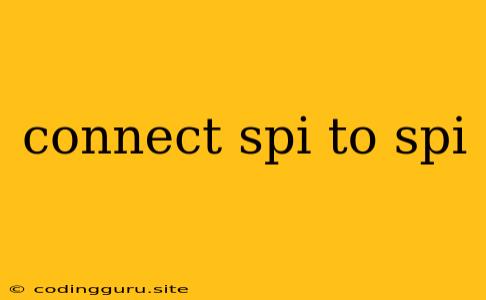Connecting SPI to SPI: A Comprehensive Guide
Connecting SPI devices to each other can be a powerful way to build complex systems, but it can also seem intimidating for beginners. This guide will break down the basics of SPI communication and provide clear steps for connecting two SPI devices.
Understanding SPI
SPI (Serial Peripheral Interface) is a synchronous serial communication protocol commonly used in embedded systems. It allows two devices to communicate with each other over a shared bus. The beauty of SPI lies in its simplicity: it uses only four wires to transfer data:
- MOSI (Master Out Slave In): This wire carries data from the master device to the slave device.
- MISO (Master In Slave Out): This wire carries data from the slave device to the master device.
- SCK (Serial Clock): This wire provides a clock signal that synchronizes data transmission between the master and slave.
- CS (Chip Select): This wire is used by the master device to select the specific slave device it wants to communicate with.
Connecting Two SPI Devices: A Step-by-Step Guide
-
Choose Your Devices: The first step is to identify the SPI devices you want to connect. Ensure both devices are compatible with SPI communication. Look for data sheets that specify the SPI communication parameters, such as clock speed, data bit order, and polarity.
-
Understand the SPI Parameters: Carefully analyze the data sheets of both devices to determine the SPI parameters like clock speed, data bit order, and polarity. These parameters must be configured on both master and slave devices to ensure seamless communication.
-
Connecting the Wires: Connect the SPI wires from the master device to the corresponding pins on the slave device:
- MOSI (Master Out Slave In): Connect this wire from the master's MOSI pin to the slave's MISO pin.
- MISO (Master In Slave Out): Connect this wire from the master's MISO pin to the slave's MOSI pin.
- SCK (Serial Clock): Connect this wire from the master's SCK pin to the slave's SCK pin.
- CS (Chip Select): Connect this wire from the master's CS pin to the slave's CS pin.
-
Configure the Master Device: The master device needs to be programmed to communicate over SPI. This involves:
- Setting the SPI mode: This defines the clock polarity and phase.
- Setting the clock speed: This determines the rate of data transmission.
- Configuring the data bit order: This specifies the order in which data bits are sent and received.
-
Configure the Slave Device: The slave device needs to be set up to receive data from the master. This typically involves:
- Setting the SPI mode: Similar to the master, the slave needs to be configured with the correct SPI mode.
- Setting the clock speed: Ensure the slave device is configured with the same clock speed as the master.
- Handling CS signal: The slave device needs to respond to the CS signal from the master.
-
Testing the Connection: After connecting and configuring the devices, test the communication. Send a test message from the master device and receive a response from the slave. Monitor the communication using a logic analyzer or oscilloscope to ensure data is being transmitted correctly.
Tips for Successful SPI Communication
- Data Sheet is King: Always refer to the data sheets of your SPI devices to understand their specific requirements and configurations.
- Check Clock Speed: Ensure the clock speed is within the specifications of both devices. Using a too high clock speed may result in communication errors.
- Check Polarity and Phase: Make sure both master and slave devices are using the same SPI mode (polarity and phase).
- Check the CS Pin: Verify that the CS pin is connected correctly and is being activated only when communicating with the specific slave device.
- Use a Logic Analyzer or Oscilloscope: These tools can be invaluable for debugging SPI communication issues by visualizing the signals on the bus.
Conclusion
Connecting SPI devices can seem daunting, but with a thorough understanding of the SPI protocol and careful attention to device specifications, it can be a straightforward process. Remember to consult the data sheets, choose the correct configuration parameters, and test the connection thoroughly. By following these steps, you can create a robust and reliable communication link between your SPI devices.
